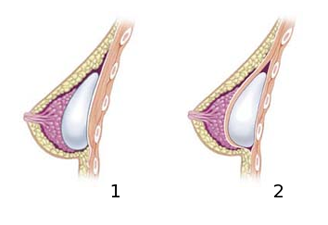Prognosis With Breast Implant–Associated Lymphoma
A study aimed at defining the natural history of breast implant-associated anaplastic large-cell lymphoma found that outcomes differ between those cases where the disease is confined within the fibrous capsule surrounding the implant and those where a mass is present in the breast.
1) Breast after subglandular augmentation; 2) Breast after submuscular augmentation

A study aimed at defining the natural history of breast implant–associated anaplastic large-cell lymphoma (ALCL) found that outcomes differ between those cases where the disease is confined within the fibrous capsule surrounding the implant and those where a mass is present in the breast. The patients with a mass have more aggressive disease, and thus more aggressive management is justified.
ALCL is a subtype of T-cell lymphoma, and the first cases associated with breast implants were reported in the late 1990s. Since then, several small series and case reports have been published, and the US Food and Drug Administration has reported 60 registered cases. “As the number of reported cases continues to grow, the association between breast implants and ALCL has become more striking,” wrote researchers led by Robert Miranda, MD, of MD Anderson Cancer Center in Houston. “This lymphoma usually presents as an effusion around the breast implant, commonly called a ‘seroma’ by doctors,” Miranda said in an e-mail.
Because of the relatively low number of cases to-date, ideal management and natural history of this malignancy has not been clearly elucidated. Miranda and colleagues conducted a review of the 60 cases available in the literature to fill those gaps. Results were published online ahead of print on December 9 in the Journal of Clinical Oncology.
They found that the median overall survival for all patients was 12 years. A total of 42 patients had disease confined to the fibrous capsule around the implant, and 39 of those (93%) achieved complete remission. In those 18 patients with a mass, 13 (72%) achieved complete remission.
Overall survival was 12 years for those patients with a mass, while median overall survival was not reached in those without a mass (P = .052). All patients with no mass survived to five years, compared with 75% of those with a mass (P = .0308). The median progression-free survival for the full cohort was not reached, but it was 1.8 years for those with a mass in the breast.
Treatment data were available for 55 of the 60 patients. Of those, 39 received systemic chemotherapy, 12 opted only for “watchful waiting” and 4 received radiation therapy only. Both overall survival and progression-free survival were similar between those patients who did and did not receive chemotherapy.
The authors noted previous research that has suggested a very low incidence of this malignancy, possibly as low as 1 per 500,000 women who have received breast implants. Still, it may be an underreported disease, given that pathologic examination of excised tissue during cosmetic surgery is not a universal practice. “It is suspected that awareness of the disease among clinicians, surgeons, and pathologists may lead to an increase of reported cases,” Miranda said.
The generally good progression-free and overall survival seen in the published cases led the authors to suggest that conservative management may often be the best course of action in these patients.
Miranda said that when patients present with the effusion around the implant, the disease “can be cured if implants and capsules are removed at once.” Patients in whom diagnosis is delayed and more aggressive disease is present clearly do need chemotherapy or radiation therapy along with removal of the implant. “The optimal therapy is still undetermined,” Miranda said.
Highlighting Insights From the Marginal Zone Lymphoma Workshop
Clinicians outline the significance of the MZL Workshop, where a gathering of international experts in the field discussed updates in the disease state.